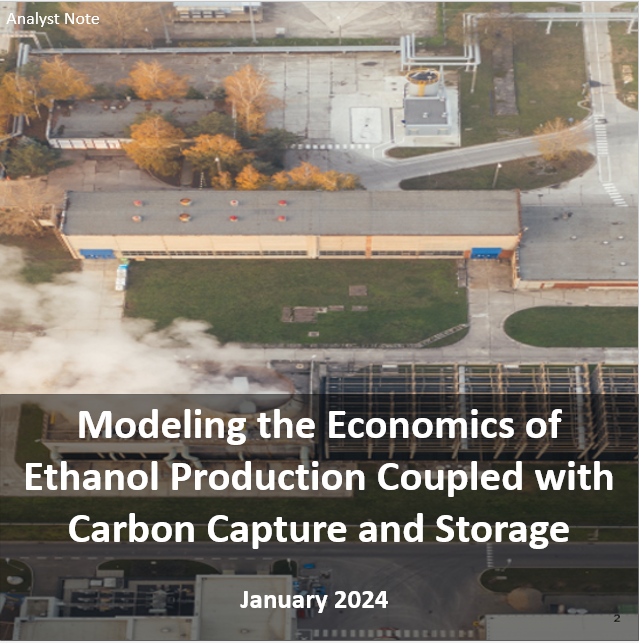- Home
- Markets
- Cap & Trade
- Clean Fuels Standard
- Carbon Offsets
- Carbon Linked Mechanisms
- Get to Know
- Market Coverage
- Cap & Trade
- Clean Fuels Standard
- Carbon Offsets
- Carbon Linked Mechanisms
- Use Cases
- About us
- Membership Plans
- InSights
- Webinars
- Scenario Simulators
- CAFÉ
- CAFÉ – Carbon Analysis Forecasting Engine Enter my CAFÉ
- Cap-and-Trade
- Clean Fuel Standards
- Carbon Offsets
- InSights
- Modeling the Economics of Ethanol Production Coupled with Carbon Capture and Storage | Analyst Note | January 2024
Modeling the Economics of Ethanol Production Coupled with Carbon Capture and Storage | Analyst Note | January 2024Friday, 26th January 2024
In this analyst note we establish a modeling framework and evaluate the viability of technologically ready ethanol production coupled to capture in the United States. The analysis considers different units and activities of operation, location, and lifecycle carbon emission assessment to find out the key bottlenecks in the ethanol-ccs value chain. The modeling framework establishes a methodology to evaluate various least cost source-sink relationships and aggregation opportunities for carbon flow across a value chain. The framework has been simulated for an ethanol production facility with a production capacity of 40.8 million gallons per year. Moreover, the impact of capacity utilization factor and carbon capture factor on revenue and margin generation has been assessed. The model considers more than 45 configurable variables. Production of ethanol releases CO2 concomitantly of which 90% could be captured and compressed for pipeline transport. The total cost of capture and storage of CO2 coming out of ethanol production isa under $31/MTCO2. A sequestration credit along with California LCFS and RFS credits provides an opportunity to permanently sequester CO2 coming out of ethanol production.
This framework can be used to analyze: a) growth of carbon capture, transport, and sequestration for any industrial sector; b) economics of conventional and advanced biofuels when integrated to upcoming carbon removal technologies; c) development of carbon-negative fuels; d) the interaction of carbon capture polices on the mandates of low-carbon fuel policies across the United States.
This report is for members only. Purchase Report
Explore Membership Options to get access to this InSightcCarbon has mapped both the demand as well as supply of SAF to size the market. The research indicates that global SAF consumption in 2022 (as per offtake agreements) stood at 494 million litres.See MembershipsYou might also likeRGGI Market: Forecasting the Landscape | Analyst Note | April 2024 Alberta TIER Market Analyst Note: A new model for North American carbon markets | Analyst Note | April 2024 California LCFS Market Outlook Ahead of New Regulations Coming In | Analyst Note | April 2024 View All Analyst NotesAnalyst Notes
Outlook for Voluntary Renewable Energy and Unbundled Voluntary Certificates in the USA | Insight Report | February 2024 North American Renewable Natural Gas Outlook 2030 | Insight Report | January 2024 North American Renewable Diesel Outlook 2030 | Insight Report | October 2023 View All Insight ForecastInsight Forecast





- No data Found!
Free Trial or Login to access
Our market portals and InSights are only for logged-in users with the relevant access. This can be you too…
Your Current Membership Does not Include this Content
This content is outside of your current package. If you need this too, let’s talk…
Solve Your Problems
Send this problem to our Clients team, and we will get back to you shortly with a plan of attack.
orSpeak and exchange notes with our specific-market expert, use your complimentary hours.
Arrange with Client TeamLet's Connect
Tell us who you are, and what you're after. We'll find you the right person with the answer - before you wake up twice.
Request Access to Data Tool
Tell us who you are, and what you're after. We'll find you the right person with the answer - before you wake up twice.
Newsletter Sign Up
Your name and email in exchange for staying up to date across the world's environmental markets... what a deal?!
MEMBERSHIPS
Sign Up for Free Trial or Login to Access Market Dashboard
Your Current Membership Does not Include this Content
This content is outside of your current package.
If you need this too, let's talk…My Saved Selections
Phasellus tempor tincidunt sem, sed dictum ipsum mollis vitae. Maecenas eu diam convallis, pellentesque lacus et, mollis enim.
ID # Custom Name Created On Insert From My Saved Selections
Phasellus tempor tincidunt sem, sed dictum ipsum mollis vitae. Maecenas eu diam convallis, pellentesque lacus et, mollis enim.
# ID Custom Name Created On My pinned contentThere is no pinned content to display - Clean Fuel Standards
- Clean Fuels Standard
- Cap & Trade
- Clean Fuels Standard
- Cap & Trade


 Webinar
Webinar